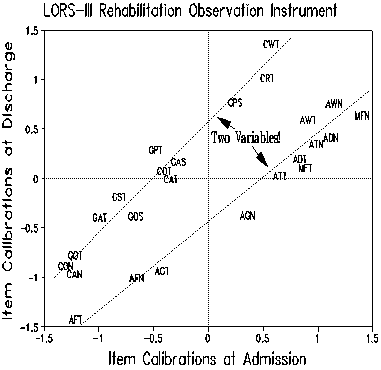


Unidimensionality is essential to utility. Yet anything examined closely is multidimensional. Nevertheless, a variable can be treated as having one basic meaning so long as the inevitable heterogeneity in manifestations of the variable do not confuse measurement in any conspicuous way. Examination of the Level of Rehabilitation Scale (LORS-III, Formations in Health Care, Inc.) discovered such a conspicuous confusion.
The 27 items of LORS-III are rated by a patient's nurses and therapists at admission to rehabilitation and at discharge. Two items are mainly diagnostic. We examined the other 25 for their utility in defining a stable variable by calibrating the item difficulties with a sample of 3,060 patients at admission and discharge.
 |
 |
 |
The LORS-III plot shows the result. Item calibrations define two conspicuously different lines. The first letter in each item code indicates item focus: "A" is Activity of daily living, "M" is Mobility, "C" is Communication, "G" is coGnition. The second letter identifies the observed process, e.g., "F" is Feeding. The third letter represents the rater, "N" for Nurse, "T" for Therapist, "S" for Speech pathologist. Thus "CWT" is Communication in Written expression rated by a Therapist.
The conspicuous difference between the two variable lines in the calibration plot brings out a confusion in the meaning of the measure. A one logit change from admission to discharge means less improvement on the activity "A" and "M" items, than on the mental "C" and "G" items. Since accurate measurement is essential to determining patient status, therapy effectiveness, and even hospital payment, measures with this degree of ambiguity are impractical. A similar finding has been reported for the FIM (Granger et al. 1993).
This motivated us to examine the activity and mental items separately. Calibrations of the activity items alone, at admission and discharge, are shown in the Activity plot. Now the item calibrations follow the identity line. "AFT" - Activity of Feeding rated by Therapist is a mild outlier. Since therapists do not feed patients, they may not know exactly how much help patients need.
We also calibrated the mental items alone at admission and discharge. Their calibration plot also follows one line, but tilted slightly from the identity line. It seems that raters are better able to discriminate patient functioning at discharge than at admission. This spreads out item difficulties. This is most likely an effect of increased familiarity with patients, and greater patient motivation to exhibit their actual functional levels. On admission, shy patients will appear less functional in higher communication skills than their actual capacities. On this logic, the discharge item calibrations are more valid than the admission ones. Further, since the decision to discontinue rehabilitation depends on discharge measures, they are more important to the patient. Since the measurement of improvement requires the same measurement system at admission and discharge, the discharge system is preferred for its usefulness.
Magalhaes L, Velozo C, Pan A-W, Weeks D. (1993) Medical Multidimensionality. Rasch Measurement Transactions, 7:1 p.265-6.
Granger C.V., et al. (1993) Performance profiles of the Functional Independence Measure. American Journal of Physical Medicine and Rehabilitation 72:2, 84-89.
Medical multidimensionality. Magalhaes L, Velozo C, Pan A-W, Weeks D. … Rasch Measurement Transactions, 1993, 7:1 p.265
| Forum | Rasch Measurement Forum to discuss any Rasch-related topic |
Go to Top of Page
Go to index of all Rasch Measurement Transactions
AERA members: Join the Rasch Measurement SIG and receive the printed version of RMT
Some back issues of RMT are available as bound volumes
Subscribe to Journal of Applied Measurement
Go to Institute for Objective Measurement Home Page. The Rasch Measurement SIG (AERA) thanks the Institute for Objective Measurement for inviting the publication of Rasch Measurement Transactions on the Institute's website, www.rasch.org.
| Coming Rasch-related Events | |
|---|---|
| Jan. 16 - Feb. 13, 2025, Fri.-Fri. | On-line workshop: Rasch Measurement - Core Topics (E. Smith, Winsteps), www.statistics.com |
| Apr. 8 - Apr. 11, 2026, Wed.-Sat. | National Council for Measurement in Education - Los Angeles, CA, ncme.org/events/2026-annual-meeting |
| Apr. 8 - Apr. 12, 2026, Wed.-Sun. | American Educational Research Association - Los Angeles, CA, www.aera.net/AERA2026 |
| May. 15 - June 12, 2026, Fri.-Fri. | On-line workshop: Rasch Measurement - Core Topics (E. Smith, Winsteps), www.statistics.com |
| June 19 - July 25, 2026, Fri.-Sat. | On-line workshop: Rasch Measurement - Further Topics (E. Smith, Winsteps), www.statistics.com |
The URL of this page is www.rasch.org/rmt/rmt71a.htm
Website: www.rasch.org/rmt/contents.htm